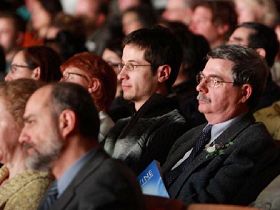Montreal, Canada: DPA Show a Sensational Success in the City of the Arts (Photos)
(Clearwisdom.net) On the evening of January 16, 2009, Divine Performing Arts (DPA) New York Company started its three-day performance at Place des Arts in Montreal. Compared to the -10F cold outside, the packed theater, filled with joy and excitement brought by DPA, was another world. Beautifully portrayed by the New York-based performing arts company, the 5,000-year divine culture of China brought a sensation to the city of the arts of Canada.
Artist Couple: A Beautiful Show
For the Steinwolds, one a musician, the other a dancer, the first Divine Performing Arts show at Montreal's Place des Arts theater on Friday was a night to remember.
Mr. Steinwold played piano for 25 years before retiring. His wife, Mrs. Steinwold, was a ballet dancer for one of Canada's top ballet companies, and performed for almost as long.
|
|
"It was a beautiful show," said Mr. Steinwold, adding that the presenters should be proud.
"It was beautiful, beautiful show," echoed Mrs. Steinwold, "Well disciplined, very graceful, beautiful dancers...excellent dancers," she said. "Wonderful, wonderful. Very well rehearsed."
While Mrs. Steinwold noted that the dance itself was totally different from ballet, she could see that the dancers had a lot of discipline and had worked hard.
"Hours of practice. Hours and hours of rehearsal," added Mr. Steinwold, who had watched a great deal of dance over the years of seeing his wife and others perform.
"Discipline and hard work," they said together.
Mrs. Steinwold said she was most impressed by how "very very focused," the dancers were.
"You could feel it from them, every one of them," she said.
Mr. Steinwold said the difference of the arms in classical Chinese dance compared to the classical European dance really stood out for him. He explained, "If you watch the arms, compared to the classical dance that we're used to from France and Russia, they're very, very soft, very gentle. Beautiful, very special... To see this kind of dance, it's very beautiful. The costumes, the lighting, the sound, everything is spectacular, and the musicians, the singing... The tenor was fabulous and the soprano, and the baritone, I rarely hear a baritone."
"And the pianist too," added Mrs. Steinwold. "They were all excellent. Excellent. Excellent. It was a beautiful show."
The former ballerina said that she especially appreciated the colorful costumes. "They are beautiful, beautiful," she said. "They were magnificent, really, really beautiful," she described.
"The costume designer must have had experience in dancing because you have to be able to dance in those costumes... [It's not] easy to design a costume for dancing," noted Mr. Steinwold, adding that sometimes costumes that are not well designed can impede the dancer's movements.
He said he was impressed by how the costumes worked with the dances, and that he enjoyed the ribbon dancing as well.
"I'm sure they rehearsed a lot. Many rehearsals with the costumes to make sure that they don't get caught [in the ribbons]," said Mrs. Steinwold.
She added that she had no idea that traditional Chinese dance included the kind of leaps and flips people normally associate with gymnastics.
Such moves were later taken from Chinese dance and incorporated into gymnastics.
"It doesn't come from gymnastics, it comes from the dancing, so that is something I learned."
She also enjoyed the choreography.
"It's wonderful. The choreography for the music is fabulous, it's fabulous. The Phoenix was very beautiful. The whole thing was beautiful," she added.
For millennia the phoenix has been esteemed as sacred, and regarded as the king of all birds. In "The Mystical Phoenix," the dancers wear long, flowing dresses to express both the regality and majesty of this creature through distinctive arm movements and quick, light steps.
"I love the piece with the chopsticks," she added.
That piece, "Mongolian Chopsticks," shows the vivacity of ethnic dance from China's hinterlands, which bursts forth in the contagiously joyful and festive use of chopsticks by Mongolian women. The charm of the region's sprawling plains is mirrored by the passionate warmth of the dancers, who use bundles of chopsticks to greet guests.
Mrs. Steinwold said she also enjoyed the variety of dance and how classical Chinese dance makes use of a variety of props.
"It reinforced what I knew already about the Chinese culture, is that they're very disciplined in whatever they do."
"The whole production was just very, very professional," said Mr. Steinwold. "I understand why it's $200 a ticket," he said, adding that he had bought some of the best tickets in the house.
"It was well worth it....It costs a lot of money to do a production like that, lots of money. And we're going to go on their website, we're going to find out more about them, about the company."
As a musician, he also commented on one of his favorite musical elements of the show -- China's two-stringed violin, the erhu. "Absolutely beautiful," he said.
Internationally Recognized Fashion Designer: It was a total delight
MONTREAL--"Sublime" would be the word that best describes the Divine Performing Arts show according to an internationally recognized fashion designer who was interviewed at the show's Montreal premiere at the Maisonneuve theater of Place des Arts on Friday Jan. 16.
Mr. Joseph, who was originally from Haiti before coming to Canada, has worked with some of fashion's greatest names and has also designed for the performing arts. He has worked around the globe and now works on his own designs which are available in the capitals of fashion. He has also collaborated closely with renowned designer and director Thierry Mugler.
Speaking in French, Mr. Joseph described a parallel of color between Chinese culture and Haitian culture.
"In Haiti, the colors are so vibrant," he said, noting the bright colors of the Divine Performing Arts dancers as well.
"Not only were there a lot of shades, it is also the silk that holds the colors really well. While in Haiti it would be more cotton, it's not the same thing. There is this strong sense of refinement, the pursuit of perfection in everything. I'm not saying that in Haiti this is not so, but the Chinese really aim for perfection."
"It was a total delight. It was calming, with no aggressiveness. It was really so relaxing," he said.
"What I loved the most was in the dance "Welcoming Spring," the gradation of greens, the pink fuschia of the fans, which when opened became flowers. The background and all the decor, it's definitely this one that really blew me away!" said Mr. Joseph.
"Welcoming Spring" features quick footwork, crisp movements, and stunning bursts of color that form the basis of a women's fan dance.
"It was very inspiring! You have this flow of silk and embroidery. One would have liked to have touched it with the hands. In general, embroidery weighs down a garment, but the silk still held its fluidity. It was really extraordinary! I think I'm a little jealous of the costume designers who had the chance to work on this show."




